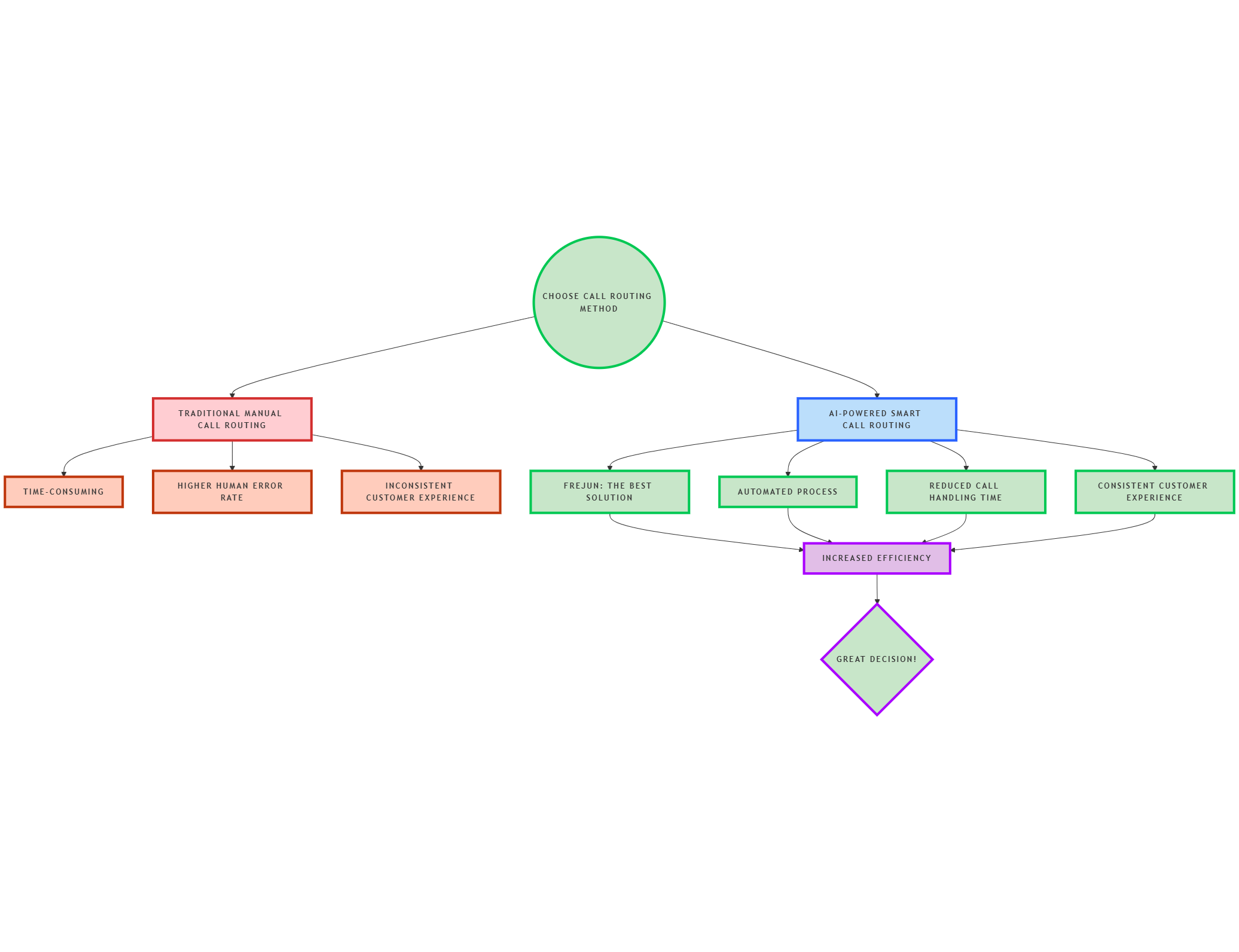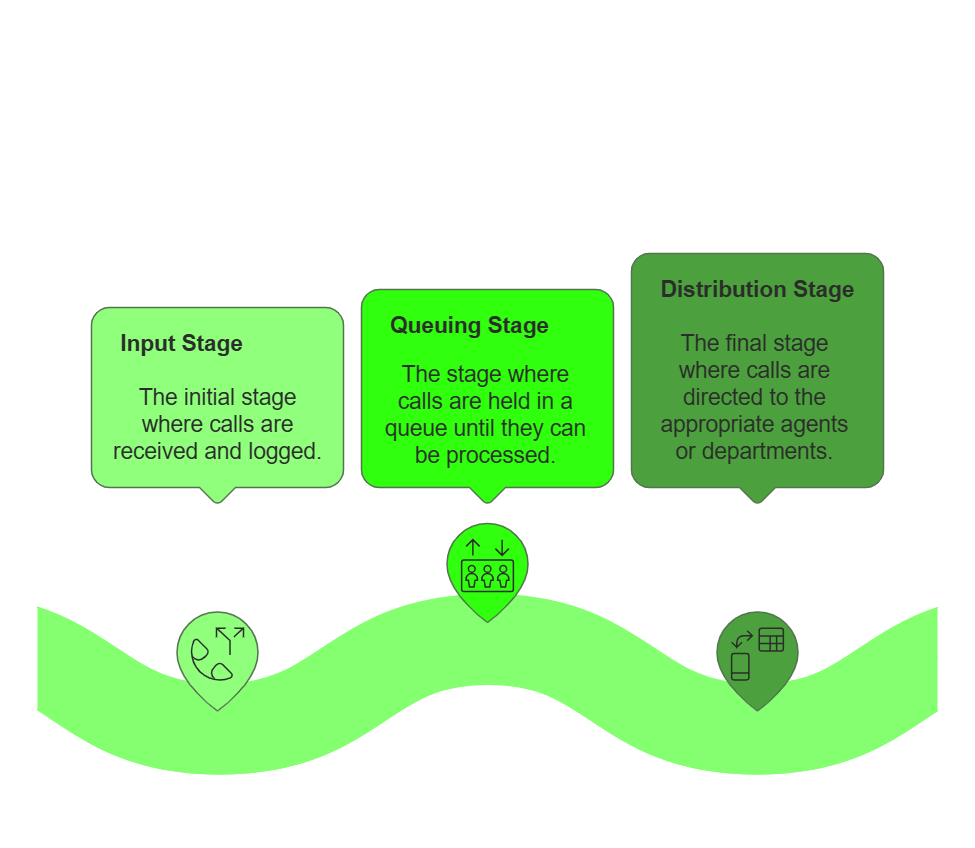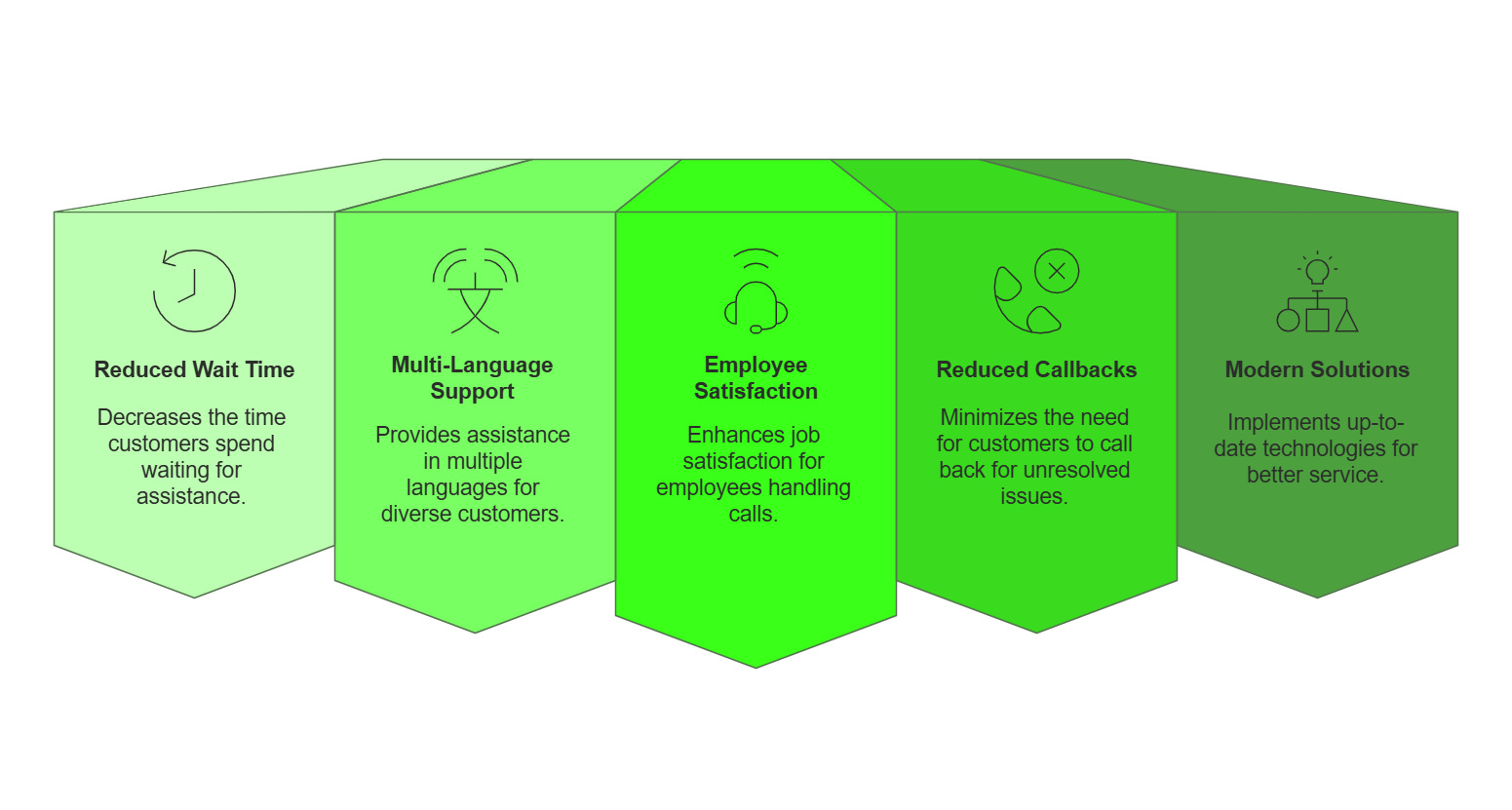Last updated on November 8th, 2025 at 03:57 pm
In an increasingly customer-centric world, how your business handles incoming calls can significantly impact customer satisfaction and loyalty. Intelligent Call Routing the method that directs incoming calls to the most appropriate agent or department plays a critical role in a business’s communication strategy. Therefore, in 2025, advanced technologies like AI, machine learning, and cloud-based systems will evolve call routing, making it more efficient and personalized than ever before.
Table of contents
- How Does Intelligent Call Routing Improve Customer Experience and Team Productivity in 2025?
- Smart Call Routing Scenarios
- Traditional Call Routing vs. AI-Powered Call Routing
- How Does Call Routing Work?
- Let’s Understand this Better with the Help of an Example
- Best Practices of Call Routing
- Benefits of Call Routing
- Major Call Routing Strategies
- What are the Different Ways to Call Routing?
- Conclusion
- Frequently Asked Questions
How Does Intelligent Call Routing Improve Customer Experience and Team Productivity in 2025?
Intelligent call routing is the process of automatically directing incoming calls to the most appropriate department, agent, or system based on pre-set rules like caller intent, IVR selections, business hours, or agent availability. In 2025, businesses heavily rely on smart routing to reduce wait times, resolve issues faster, and personalize customer support.
Platforms like FreJun enable seamless call routing by integrating with CRMs, analyzing call data in real-time, and using AI to make smarter routing decisions. Whether you’re a small business or an enterprise, intelligent call routing powered by tools like FreJun ensures that customers reach the right person at the right time improving satisfaction and overall team productivity.
Smart Call Routing Scenarios
| Scenario | Call Routing Type Used |
| Customer needs technical support | Skill-Based Routing |
| Call received outside business hours | Time-Based Routing |
| Customer dials from a specific country | Geographic Routing |
| Caller selects a department via IVR | IVR-Based Routing |
| VIP customers get priority handling | Priority Routing |
Traditional Call Routing vs. AI-Powered Call Routing

Schedule a demo with FreJun or Sign up to know more about it
How Does Call Routing Work?
It operates through the popular IVR (Interactive Voice Response) system, using the data customers provide when dialing your business phone number to manage the entire routing process.
There are Three Stages in Call Routing:

- Input Stage: This is the first stage when customers use their phone’s dial pad to select one among the many call menu options. Alternatively, they can use their voice to respond to pre-recorded questions.
- Queuing Stage: In this stage, the system uses the input provided in the previous stage to push the caller to the right queue.
- Distribution Stage: This is the final stage where calls in different queues are routed to the corresponding team based on pre-determined calling rules and customer data stored in the CRM tool.
Let’s Understand this Better with the Help of an Example
Imagine you are an existing customer of a travel portal. You reserved a hotel through their portal and now want to cancel it. Whenever you call the toll-free number on their website, the phone system quickly presents several options. For example, you can book a new flight or hotel, cancel or reschedule an existing booking, or check your refund status. Next, you press the corresponding number or clearly state your choice. This step starts the input stage.
The company’s phone system gauges your mobile number stored in their CRM to identify you as an existing customer and places you in the calling queue. Hence, this is the queueing stage. The phone system redirects you to the team handling hotel cancellations instead of general customer care. This feature automatically connects you to a qualified person who can resolve your query instantly. This is the distribution stage.
Best Practices of Call Routing
These are the best practice of Call Routing:
1. Make Sure the Routing Strategy Revolves Around the Customers
For starters, the entire business phone system is set up only for addressing the queries of your customers. So it makes total sense to keep them at the mantelpiece while devising the call routing strategy. By this strategy, we are mainly talking about the different menu options that you need to adopt for your IVR.
Start by researching your customers’ expectations. Study their demographics, common concerns, and the reasons they contact you. For example, if only a handful of customers call you each month for flight rescheduling, you can combine it with the flight cancellation option.
2. Track How the Routing System is Performing on a Regular Basis
Unless you track the efficacy and efficiency of a system, you will never make improvements to it. And when you make necessary improvements, customer satisfaction level increases, and your sales multiply. Start by tracking key metrics like Abandonment Rate and Average Handle Time to check how efficient your call routing system is. If these values are below average, then it’s time to alter the call routing strategy and distribution method.
3. Offer Only a Limited Set of Menu Options
Too many cooks spoil the broth, and the same holds true for call routing systems! Excessive options confuse customers, increase their waiting time, and direct them to the wrong contact center team. Keep the call menu options limited to a few essentials. This approach drastically reduces call abandonment rates.
4. Integrate Your Call Routing System with Your CRM Solution
We live in the era of customer personalization. Indeed, if you do not tailor your services to customer needs, your competitors will overtake you. Consequently, this also applies to your call routing system. Specifically, customers expect a certain level of personalization when they call your organization. For example, they expect your agents to know about their past interactions, purchase history, and service history to avoid repeating information. This is possible if your system is integrated with your CRM solution. Your agents will instantly know everything about the customer once their calls are routed to them.
Benefits of Call Routing

These are the benefits of Call Routing:
1- Reduced Wait Time for Your Customers
Here is a harsh reality – Nobody likes to wait, especially over phones. Customers of today are short of time. They want immediate service and instant resolution. It helps achieve this by drastically reducing the wait time. Right from routing the call to the right agent to agents having all the necessary information, call routing prioritizes customer experience at every stage.
2- Offers Multi-Language Support
It is a necessity if your business has customers speaking multiple languages. Call routing systems empower you to tailor the routing rules in such a way that it encompasses multiple IVR language options. This way, your customers can contact and speak with a live agent in their own language right away, without the need to speak to someone else in a language you don’t speak.
3- Improves Employee Satisfaction
Here’s some good news – not all benefits of a call routing system are directed towards customers. It drastically improves the satisfaction of your employees/agents by creating a more balanced workload. Most call routing systems let you set rules in such a way that every agent receives a similar number of calls, leading to fewer periods of idleness and better utilization of all the employees. Most importantly, your employees will not be overburdened.
4- Reduced Number of Callbacks
As you already know by now, a call routing system operates by routing a call to the agent who is best suited to handle a particular customer’s query. As a result of this, the customer gets all the necessary details about their query in a single call. This means they do not have to call back multiple times or talk to multiple persons to receive a solution. The best part – the cost per interaction also decreases since you need less time to resolve a particular query.
5- Offers Modern Solutions
Most modern call routing service or software is powered by artificial intelligence and other disruptive technologies that help you completely redefine call management operations. For instance, it can let you create customized greetings, personalized menus, and a myriad of self-service options. Some smart call routing systems even assess customer sentiment and route them to the appropriate agent with a similar personality.
Schedule a demo with FreJun or Sign up to know more about it
Major Call Routing Strategies
These are the Strategies for Call Routing:
1- Direct Routing Strategy
This is probably the simplest of all call routing strategies. Organizations employing this strategy have a simple goal – to connect the customer with the right department. For instance, if a person with a sales query calls, they will be redirected to the sales team. If the sales team is busy, the caller has to wait till someone from the team is free to attend the call.
2- Least Idle Strategy
In this, the call can be directed to the agent who has been for a call the longest. For instance, Agent A hasn’t attended a call for 15 minutes while Agent B hasn’t attended a call for 25 minutes. Clearly, the next call will be directed to Agent B. This way, you can ensure that every agent is utilized thoroughly throughout the day.
3- Skill-Based Routing Strategy
The skill-based routing strategy revolves around improving customer experience. In this, a customer’s call is transferred to the agent who has the highest skill to solve that query. If you are adopting this strategy, you must ensure that multi-skilled agents also have strong individual skills so that they will be utilized thoroughly.
4- Geographic Routing Strategy
In geographic routing, you direct a caller to the call center/store/office that’s closest to their current location. This location is typically captured through the user’s input. For example, a user is trying to contact the nearest store in their city. The IVR system asks the user to enter their zip code. Based on the response, it can redirect them to the closest store.
5- Time-Based Routing Strategy
In the time-based routing strategy, the call routing system will transfer the customer’s call to the agent based on the time and day of the call. For example, if the caller calls during a time when the business is closed in that time zone, the system will route the call to another available agent in another time zone.
6- Data-Based Routing Strategy
This strategy leverages available data and intelligence to route calls effectively. For example, if a broadband customer has a service-related query but hasn’t paid last month’s bill, the system can immediately redirect them to the collections department when they call the business phone number.
7- Value-Based Routing Strategy
This is almost similar to the previous strategy. The only difference is that the focus is on the value of the customer. To set up this strategy, integrate your call routing system with a CRM. The CRM, in turn, will bring revenue-based insights to personalize your routing system. For example, if an existing customer with a higher credit limit calls a credit card company, you can route them to the premium credit card team with higher pricing.
8- Self-Service Routing Strategy
This strategy targets customers who seek information without needing a live agent. Specifically, callers can use the IVR menu to gather the details they need by interacting with an automated attendant. For example, if a customer needs the store address, they can interact with the IVR, which immediately offers the address option. As a result, there is no need to speak with a live agent.
What are the Different Ways to Call Routing?
Here are some different methods for call routing:
1- Round Robin Call Routing
In this method, you route calls equally across your agents. For example, if your organization has 10 agents, the first agent receives the first call. After they accept the call, the second call goes to the second agent, and so on. This approach ensures an even distribution of calls among all agents
2- Uniform Call Routing
In this approach, calls are routed based on agent availability, similar to the least idle strategy, where the system routes the next call to the longest available agent. After handling a call, the system places the agent at the end of the line. This approach ensures fair call distribution, but it prioritizes availability over specific skills.
3- Weighted Call Routing
In this, calls are routed based on the weights of the agents. The weights are assigned manually to each agent in your organization. For example, imagine your organization has 3 agents – Agent A with 50 points, Agent B with 20 points, and Agent C with 30 points. Out of 100 incoming calls, 50 calls are routed to Agent A, 20 calls are to Agent B, and 30 calls are routed to Agent C.
4- Simultaneous Call Routing
Another simple call routing technique. In this technique, whenever a customer calls, all the assigned agents’ phones will ring at the same time. Whoever is available can answer the call first. This technique can be adopted by those organizations that value speed over anything else.
How to Optimize Call Routing for 2025
- Use Data Analytics to Continuously Improve:
Monitor call volume trends, peak times, and agent performance. Using data analytics, businesses can adjust routing strategies, allocate resources more efficiently, and identify training needs. - Prioritize First-Call Resolution:
Ensuring calls are routed to the correct agent who can resolve the issue on the first call is vital. Optimize your call routing strategy for first-call resolution by implementing skills-based and AI-powered routing systems. - Ensure Seamless Omnichannel Integration:
As customers interact with businesses across multiple channels, it’s essential to maintain consistency in the routing process. Implement an omnichannel solution that can handle phone calls, emails, chats, and social media messages, providing customers with a seamless experience regardless of the platform they choose. - Adopt Cloud-Based Solutions for Scalability:
Invest in cloud-based call routing systems that can scale as your business grows. This will allow you to handle increasing call volumes without compromising service quality.
Conclusion
Call routing evolves rapidly, with AI, cloud technology, and data analytics shaping the future of customer service. By adopting the right call routing system in 2025, businesses can enhance customer experience, boost operational efficiency, and reduce costs. Whether you aim to streamline customer support, improve first-call resolution, or integrate new technologies, mastering call routing becomes crucial for success in today’s competitive market.
If you are on the lookout for a next-gen cloud telephony system, your search ends with FreJun. FreJun comes with advanced features like call logging, auto-dialer, call scheduling, and plug-and-play integrations, to name a few. To experience the power of FreJun, sign up for a free trial now.
Further Reading: Top 11 SIP Trunk Providers In India
Frequently Asked Questions
A call routing works in 3 stages: Input stage, queuing stage, and distribution stage. In the input stage, customers select one among the many call menu options in the IVR. Next, in the queueing stage, the caller is pushed to the correct queue based on their input. Finally, in the distribution stage, the callers are transferred to the final team who they wish to talk to.
Call routing in VoIP is the process of pushing calls into a particular queue based on a predefined criteria.
The different types of call routing are round robin, uniform, weighted, and simultaneous.
There are many service providers who offer free call routing as part of their calling plans. You can check them out in the internet.
Popular call routing strategies include direct routing, least idle, skill-based, geographic, time-based, value-based, and self-service.
Yes, advanced systems like FreJun offer fully automated and intelligent call routing using machine learning and real-time data.
Absolutely. Tools like FreJun offer cloud-based routing features without needing hardware setups.
